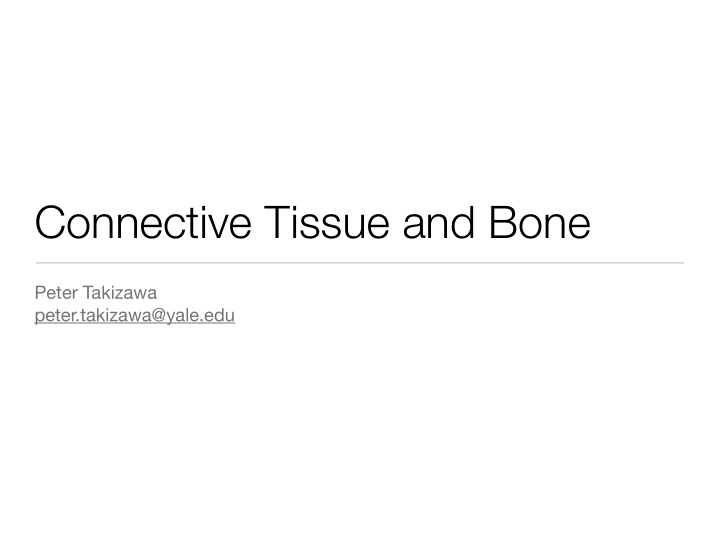



Connective Tissue and Bone Peter Takizawa peter.takizawa@yale.edu
What we will talk about… • Types and functions of connective tissue • Cells of connective tissue • Composition and structure of bone • Cells that control the shape and integrity of bone • Development of bone
Connective tissue serves a variety of functions throughout the body. Resist stress Organize tissues Connective Tissue Immunity Metabolic Bacterium Fat cell Macrophage
Connective tissue can generate a range of mechanical strengths. Bone Cartilage Tendon Organ Blood Support Vessels
Connective tissue resists tension and compression. Collagen Elastin Glycosamino- glycans
Connective tissue can be classified based on the amount and organization of collagen. Dense Regular Dense Irregular Loose Glycoproteins Collagen Collagen
Reticular fibers are composed of type III collagen and organize cells in organs. Cells Reticular Fiber
Adipose tissue contains adipocytes that store large amounts of lipid and triglycerides. Cytoplasm Lipids Nucleus
Brown fat stores lipids and triglycerides and generates heat. Lipid Droplets Nucleus
Cells of connective tissue
Fibroblasts are prominent in connective tissue and synthesize most of the protein components. Areolar Tissue Collagen Fiber Collagen Fibroblast
Mast cells store and release histamine during an immune response Mast Cell
Macrophage engulf foreign particles and cellular debris. Macrophage
Cartilage
Chondrocytes synthesize cartilage which resists compression. Nucleus Matrix Lipid Droplets Chondrocyte
Hyaline cartilage contains type II cartilage and glycosaminoglycans. Toluidine Blue H&E Perichondrium Matrix Chondrocytes
Fibrocartilage contains a large amount of type I collagen. Collagen Fibers Matrix Chondrocytes
Elastic cartilage contains elastic fibers and type II collagen. Elastic Fiber Chondrocyte
Bone
Bone serves mechanical, metabolic and cellular functions. Ca 2+
The major structure components of bone are calcium-phosphate crystals and type I collagen. Collagen Composition of bone Ca 2+ cyrstals Mineralized collagen fibril Fibril
Bone can be arranged in lamellar or woven forms. Lamellar Woven
Architecture of bone
Compact bone and trabecular bone are two structures in most bones. Trabecular Bone Epiphysis Endosteal Surface Periosteal Surface Diaphysis Compact Bone
Compact bone is organized into circumferential lamellae and Haversian systems. Circumferential bone Haversian system Periosteal Surface Haversian Canal Volkmann’s Canal
Volkmann’s Canal Haversian Canal
Bone Cells
Osteoblasts secrete collagen and catalyze the crystallization of calcium on collagen fibers.
Osteoblasts synthesize osteoid that mineralizes into bone. Osteoblast d i o e t s O Bone Osteoid Bone
Osteocytes are osteoblasts that become trapped in bone matrix. Osteoblast Osteocyte
Ground section of Haverisan System showing osteocytes and their filopodia Haversian Canal Filopodia Osteocyte
Osteocytes communicate via gap junctions on filopodia. Osteocyte Gap junction Bone Filopodia Canalicullus
Osteoclasts
Osteoclasts secrete acid on bone to dissolve calcium-phosphate crystals. Cl - CO 2 H 2 O CA HCO 3- CO 2 ADP P i H + Cl - ATP H + H + Cl - Cl -
Osteoclasts secrete cathepsin K onto bone to digest collagen.
Transcytosis delivers digested bone matrix components to basal side of osteoclasts.
Histological image and electron micrograph showing an osteoclast Osteoclast Bone Bone
Dynamics of bone turnover
Bone is a dynamic material that undergoes synthesis and resorption. Synthesis Increase length or store Ca 2+ Resorption Increase Ca 2+ levels Resorption Maintain integrity Synthesis
Osteoblasts and osteoclasts reshape bone and replace old bone. Reshape Bone modeling bone Replace Bone remodeling bone Osteoblast Osteoclast
Bone modeling
Bone modeling shapes bone with osteoblasts and osteoclasts working on different surfaces.
Trabecular bone aligns along lines of stress.
Periosteal apposition and endocortical resorption increase diameter of bone. Seeman (2008) J Bone Miner Metab 26 1-8
Osteocytes use a primary cilium to detect mechanical stress in bone. Primary cilium Fluid flow Ca 2+
Bone remodeling
Bone remodeling removes old bone and replaces it with new bone. Compact bone Trabecular bone
Remodeling repairs bone with osteoclasts and osteoblasts working on the same surface. Activation/Resorption Formation Reversal
Basic multicellular unit consists of osteoclasts, osteoblasts that remodel compact bone. Osteoblast Osteoclast Kerr Atlas of Functional Histology 1st edition
Remodeling erodes old Haversian Systems while forming new canals. Resorption Formation
Development of osteoclasts
Pre-osteoclasts are activated by M-CSF and RANK ligand on the surface of osteoblasts. Preosteoclast Monocyte Osteoclast RANK receptor M-CSF RANK-L Osteoblast
Osteoprotegerin is a decoy receptor for RANKL that prevents activation of preosteoclasts. Preosteoclast Osteoclast Monocyte RANK receptor M-CSF OPG Osteoblast
Parathyroid hormone stimulates osteoblasts to increases RANKL and decrease OPGs. RANK receptor Ca 2+ PTH RANK-L Osteoblast
Estrogen has direct and indirect effects on the development and lifespan of osteoclasts. Apoptosis Estrogen Estrogen Osteoblast OPG synthesis
Bone development
Intramembraneous ossification involves bone formation on mesenchymal tissue. Bone Mesenchyme Osteoblast Osteocyte
Endochondrial ossification is bone formation on cartilage. Cartilage Chondrocyte Growth Plate Cartilage Bone Osteoid Bone Marrow
The developmental sequence of chondrocytes drives bone formation in growth plates. Resting Chondrocytes Proliferating Chondrocytes Hypertrophic Chondrocytes Calcified Cartilage
Take home points... • The properties of connective tissue is determined by the and arrangement type of ECM components and the cellular composition. • Bones contain of compact bone and trabecular bone. • Osteoblasts synthesize bone and osteoclasts dissolve bone. • Osteocytes are mechanical sensors that regulate bone synthesis and absorption. • Bone modeling reshapes bone and bone remodeling replaces old bone. • Increased activity and numbers of osteoclasts leads to osteoporosis.
Recommend
More recommend